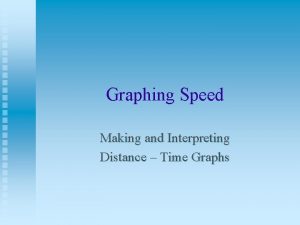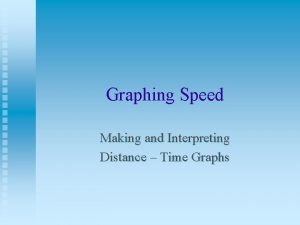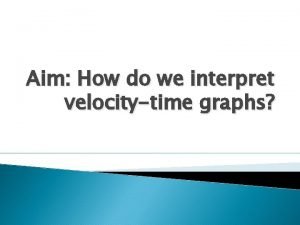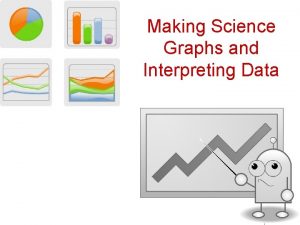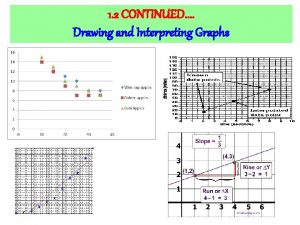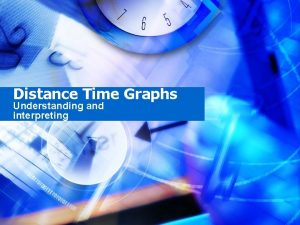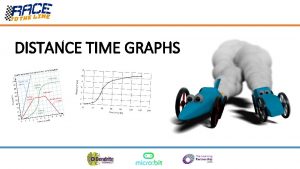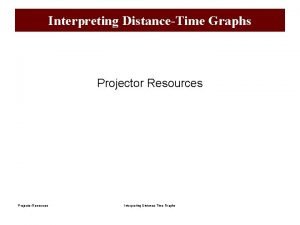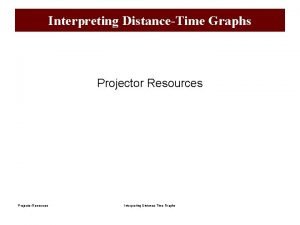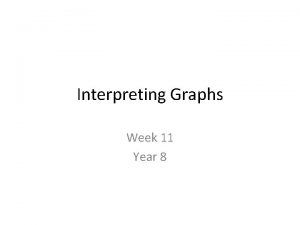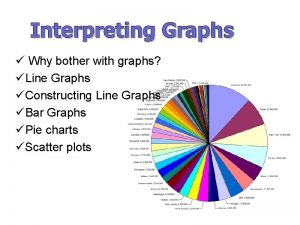Distance Time Graphs Understanding and interpreting Distance vs









- Slides: 9

Distance Time Graphs Understanding and interpreting

Distance vs. Time Graphs • In science, graphs are often used to communicate information. Plotting distance versus time can tell you a lot about a journey. Let's look at the axes: y x • Time always runs horizontally (x-axis). The arrow shows the direction of time. The further to the right, the longer time from the start. • Distance runs vertically (y-axis). The higher up the graph we go, the further we are from the start.

What does an object look like on a d vs. t graph when it’s not moving ? • If something is not moving, a horizontal line is drawn on a distance-time graph (dt-graph). • Time is increasing to the right, but its distance does not change. It is stationary.

Moving at a constant speed… • If something is moving at a constant speed, it means we expect the same increase in distance in a given time: • Time is increasing to the right, and distance is increasing steadily with time. It moves at a steady speed.

Can you describe what is going on here? • For the first part of the journey shown by the graph below, the object moved at a constant (but relatively slow) speed. • It then suddenly increased its speed, covering a much larger distance in the same time.

What is the effect of line ‘Steepness’, (a. k. a. slope)… • Both lines below show that each object moved the same distance, but the steeper yellow line got there in less time • A steeper gradient indicates a larger distance moved in a given time. In other words, greater speed. • Both lines are of constant gradient (slope), so both speeds are constant.

Change in speed (a. k. a. acceleration) • The line below is showing an increase in speed as time passes since the gradient (slope) is getting steeper (i. e. curving upwards). • In other words, in a given period of time, the distance the object moves is larger – i. e. it is accelerating.

Multiple Speed Events There are three parts to the journey shown below: • (1) Moving at a constant speed (2) Not moving for quite some time (3) Moving again, but at high constant speed

Finding speed from d vs. t graphs • We can see that the motion shown by the yellow line is fastest. • By definition, average speed = change in distance / change in time so the slope of the line will give us the speed! • Yellow: speed = D d = 30. m – 0 m = 30. m = 3. 0 m/s D t 10. s – 0 s 10. s • Blue: speed = D d = 20. m – 0 m = 20. m = 1. 0 m/s D t 20. s – 0 s 20. s
 Graphs that compare distance and time are called
Graphs that compare distance and time are called Interpreting distance time graphs
Interpreting distance time graphs Creating and interpreting distance time graph
Creating and interpreting distance time graph Interpreting distance time graphs
Interpreting distance time graphs What is the average velocity of the object
What is the average velocity of the object Tomer owns a daycare
Tomer owns a daycare Making science graphs and interpreting data
Making science graphs and interpreting data Drawing and interpreting graphs
Drawing and interpreting graphs Increasing speed distance time graph
Increasing speed distance time graph Interpreting circle graphs
Interpreting circle graphs


